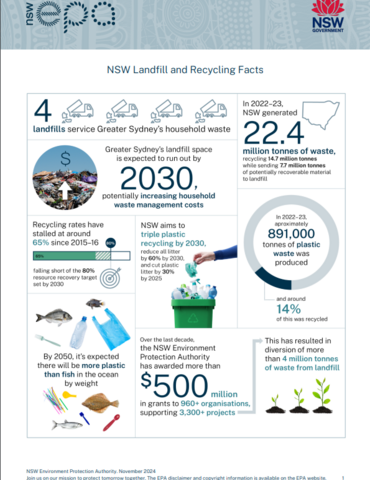Sydney landfill shortage
Greater Sydney’s landfill space is expected to run out by 2030 unless urgent action is taken.
Consultation has closed
Public consultation was open from 14 May to 25 June 2025 on the draft NSW Waste and Circular Infrastructure Plan: Meeting our residual and food and garden organic waste needs.
Stakeholder feedback will be considered in finalising the Plan. Once finalised, the Plan will guide NSW Government decision-making and investment in waste and circular infrastructure.
Without new waste solutions, landfill capacity will be exhausted within the next decade, significantly driving waste management costs up for households and businesses. This is because many Greater Sydney residents will be paying for their waste to be transported to regional areas for disposal, if landfill capacity runs out.
This added burden will put pressure on households already experiencing the cost-of-living crisis and could slow down the development of critical infrastructure, such as housing for the state’s growing population.
Recycling rates in NSW have stagnated at around 65% since 2015-16, falling short of the 80% target by 2030. The NSW Government is taking action to address the looming waste management shortfall.
- Between 2015-16 and 2022-23, waste volumes across the state rose from 18.7 million tonnes to 22.4 million tonnes.
- This trend is expected to continue with waste volumes projected to reach nearly 37 million tonnes in 2041-42.
- In 2022-23, around 66% of the waste generated in NSW was recycled and the remaining 7.7 million tonnes of unrecycled waste – known as residual waste – was disposed of at landfill.
- NSW is on the cusp of a waste crisis. There is not enough waste infrastructure in Greater Sydney to meet the demands of a growing population.
- Greater Sydney is home to 66% of the NSW population and its landfill capacity is projected to run out by 2030, unless urgent action is taken.
- By 2030, landfills servicing Greater Sydney’s households and businesses are estimated to be in shortfall by an estimated 1.1 million tonnes each year, forcing more waste volumes into regional areas – or even interstate – for processing and disposal.
- This could increase household waste management costs by 20% on average, intensifying cost-of-living pressures. This will also put huge cost pressures on councils and industry.
- Greater Sydney is also running out of ways to safely manage its construction and demolition (C&D) waste. Landfills are predicted to be in deficit by an estimated 1.9 million tonnes each year.
- The cost of managing waste from construction and demolition activities is also set to rise, which could slow down the development of critical infrastructure such as housing needed for our growing population.
- As the population of NSW continues to grow and the amount of waste households produce increases, there is only a certain amount of landfill space remaining to take this waste.
- The NSW EPA has heard planning, development and delivery of new infrastructure is being hampered by significant cost and investment risks, stemming from factors like limited land availability, complex planning requirements and construction costs.
- The NSW Government is looking at available options to address this diminishing landfill capacity and a big piece of that puzzle is the release of this draft Plan for feedback.
- Waste is moved interstate or to the regions at a high expense.
- Greater risk of illegal dumping and environmental harm.
- Increased cost of waste disposal for rate payers and businesses.
- Delays to build critical infrastructure such as new housing.
- Disruption to waste management services in extreme weather events or emergencies.
Residual waste refers to waste that is not recycled or reused. This is from both putrescible (organic) and non-putrescible (dry material) waste, from demolition and construction activities, as well as from the kerbside red bins.
Putrescible waste is waste taken from kerbside red bins containing matter that decomposes easily such as food, garden waste and other organics.
Non-putrescible waste is typically generated by construction and demolition activities.
Download

Landfill and recycling infographic Landfill and recycling infographic
